
Old Bowling Green and Walled Garden
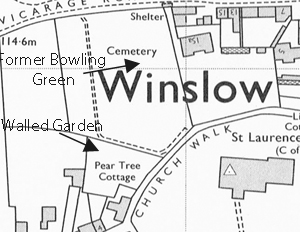 The Old Bowling Green is now the part of the churchyard adjoining Vicarage Road. The path through the churchyard partly follows its boundary. The Walled Garden is behind the wall to the west of the old churchyard and south of the new. The 1978 map on the right shows their locations. They may be the land called William Hogson's Close in the will of Ann Stevens (d.1708).
The Old Bowling Green is now the part of the churchyard adjoining Vicarage Road. The path through the churchyard partly follows its boundary. The Walled Garden is behind the wall to the west of the old churchyard and south of the new. The 1978 map on the right shows their locations. They may be the land called William Hogson's Close in the will of Ann Stevens (d.1708).
Winslow’s Bowling Green and the Walled Garden adjoining date back at least to the 18th century (according to the 1877 poem the bowling green had then been functioning for 100 years) and belonged for many years to two of the town’s premier legal families. They were the "Garden and inclosed Close of pasture Ground" which Francis Collins, grocer (d.1771), left to his servant Elizabeth Newborn along with his house (later The Bank); Francis Collins was one of George Barrett's trustees and may have separated them from the original Barrett's Close. They must have been included when Elizabeth and her husband William Turner sold the house in 1791 to James Burnham of Winslow (1733-1803), a solicitor who lived at what is now Brook Hall. He was Steward of the Manor of Winslow and Coroner for North Bucks. In his will of 7 August 1801, James Burnham left to his wife Mary "All those my three copyhold messuages or tenements [Brook Hall] with a garden mounded round with a brick wall and the Bowling Green lying adjoining to Winslow Churchyard".
James Burnham’s son James Burnham (1773-1836) was also Steward of the Manor of Winslow and Coroner for North Bucks. In his will, made 4 November 1828, he left to his wife Martha his freehold piece of garden ground adjoining the Churchyard of Winslow. The garden was advertised to be sold with other Burnham property in the Northampton Mercury, 17 July 1830, as "a freehold piece of garden ground in Winslow adjoining the churchyard and containing by estimation one rood, in the occupation of Mr James Burnham". The garden was again advertised for sale at The George on 2 February 1838 (Bucks Herald, 13 & 29 Jan), as "a freehold piece of garden ground adjoining the Churchyard in the occupation of Mrs Burnham, 1 rood" [a quarter of an acre].
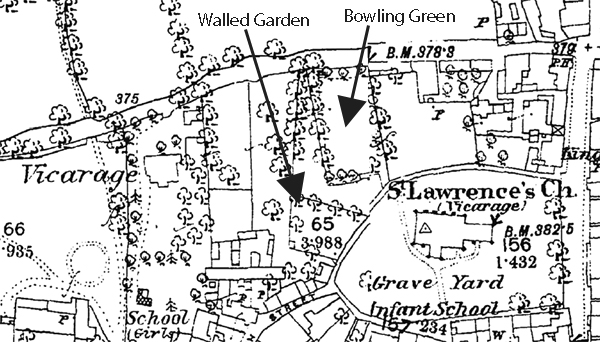
The Bowling Green and Walled Garden on the Ordnance Survey Map of 1880
The Bowling Green was not mentioned in these sales, but in the Bucks Herald of 16 May 1835, it was announced that "the Bowling Green at Winslow was opened to the subscribers on Monday. It is under the able management of Mr Alfred Barton of that town". The Winslow Rate Book of 1838 lists Alfred Barton, the proprietor of the George Inn, renting the Bowling Green from Samuel Greaves Dudley, an auctioneer and brother-in-law of James Burnham jr. Alfred Barton remained as tenant of the Bowling Green until he retired in 1876. The local newspapers report many events held on the Bowling Green, including an annual ball and annual dinner.
Bucks Herald, 10 Aug 1839
WINSLOW ANNUAL BOWLING GREEN BALL. -
Notwithstanding the unfavourable state of the weather in the morning of Wednesday last, this Ball went off highly satisfactorily to all present, and far exceeded the expectations of its best wishers, as upwards of 200 were assembled at one time in the evening, and it was gratifying to witness so numerous an attendance of ladies. The dancing commenced at four o’clock, and by seven, upwards of 20 different parties or groups were to be observed taking their tea at the different tables, after which quadrilles and country dances were followed up with great spirit and hilarity to an excellent band of music; at the close of the evening, the orchestra, a large representation of a crown, the arbour and other parts of the green were brilliantly illuminated with variegated lamps, tastefully arranged in different devices of stars, &c.; in fact the whole arrangements and accommodation were such as to reflect the highest credit upon the stewards and different spirited individuals who (notwithstanding the many difficulties they had to contend with in consequence of the unsettled state of the weather) so successfully exerted themselves in promoting the comforts and amusement of so numerous a party, which cannot fail to ensure an increased attendance at the ensuing anniversary.
Bucks Herald, 12 Oct 1839
WINSLOW BOWLING GREEN SOCIETY DINNER. –This annual festival came off on Friday, October 5, at the George Inn. Mr. George Cowley, as one of the Stewards, was on this occasion called to the Chair, supported by W. S. Lowndes, George Cooke, Ed. S. Lowndes, C. Lowndes, Ed. Wright, and John Cowley, Esqrs., and nearly all the members present, consisting of between twenty and thirty. After the usual loyal toasts, and “Prosperity to the Club” was given, the Chairman, in giving the health of “The Lord of the Manor”, announced (to the great pleasure of all present) that the gentleman’s health had undergone the greatest improvement, which was received with unmixed pleasure, and three vociferous and hearty cheers followed. The evening was spent with conviviality, “the merry song and jocund tale” adding to its hilarity.
Bucks Herald, 4 Sep 1841
On the 27th ult., the Winslow Bowling green presented its annual gathering of festivity and amusement. The green was illuminated with variegated lamps representing numerous devices; festoons of flowers overhung the orchestral stage, designed by the same hand of taste that has so often exhibited itself on similar occasions, while the throng of youth and beauty was present, and the whole presented one harmonious spectacle of enjoyment and delight.
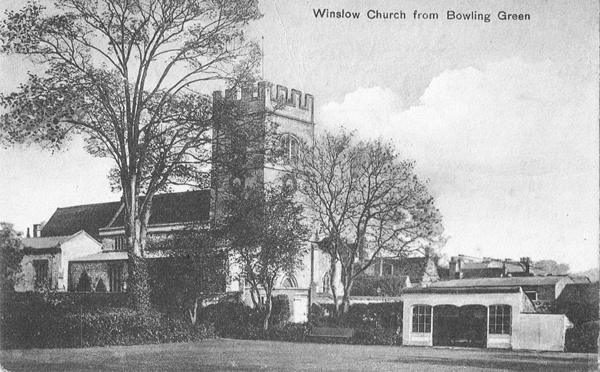
This view shows the Bowling Green from the Vicarage Road side (postcard postmarked 1914)
In 1847, Benjamin Disraeli addressed a Conservative election meeting on the Bowling Green.
Bicester Herald, 18 Sep 1868
On Thursday, September 10, a match of bowls between members of the Bicester and the Winslow Bowling Green Clubs came off on the Bicester Bowling Green. The first game between Messrs. G. Neville, T. Heritage, and A. K. Phillips, of the Bicester Club; and Messrs. Barton, Grace and Marks, of the Winslow Club, was won by the Bicester side by 13 points. The next game between Messrs. G. Neville, T. Heritage, and J. C. Neville, of the Bicester club; and Messrs. Barton, Grace and Marks, of the Winslow club, was won by the Bicester side by 11 points. The next game between Messrs. Campin, Camozzi, Simons, and W. Grimsley, of the Bicester club; and Messrs. Denne, J. King, Kelly and G. King, of the Winslow club, was won by the Bicester side by three points. The next game between Messrs. J. Campin, J. Neville T. Heritage, and W. Grimsley, of the Bicester club; and Messrs. Marks, Kelly, G. King, and J. King, of the Winslow club, was won by the Winslow side by 4 points... After the game the competitors and friends partook of a tea spread at the King’s Head Inn, Bicester.
T.P. Willis bought the Bowling Green in 1877, according to the information given at the 1911 sale, along with the Walled Garden. They were put up for sale (see below) after the retirement of Alfred Barton of The George. Mr Barton was tenant of the Bowling Green, and the owner appears to have been S.G. Dudley (d.1856), then presumably his son S.B. Dudley (see Willis family).
1877: Buckingham Advertiser, 14 April
WINSLOW, TO BE SOLD BY AUCTION, BY Messrs. DUDLEY and SON
On THURSDAY, April 19th, 1877, at the George Hotel, Winslow, at Five o’clock in the Afternoon, in three Lots.
LOT 1.- The BOWLING GREEN, containing 1r. 22p., with a frontage to the Back Lane, and an entrance from the Church-yard path.
LOT 2.- A productive KITCHEN GARDEN, adjoining Lot 1, with an entrance from the Back Lane, and a frontage to the Churchyard, containing 1r. 7p., with a wall on the south and east sides.
LOT 3.- A capital GARDEN, walled round and stocked with choice fruit trees of every description, with an entrance and a considerable frontage to the Churchyard, containing 25 poles.
The whole is Freehold, Tithe-Free, and exonerated from Land-Tax.
Early Possession may be had.
For a view apply to Joseph Seaton, gardener, and for further particulars to Messrs. Hooper and Bullock, Solicitors, Winslow; or to Messrs. Dudley and Son, Auctioneers and Land Agents, Winslow.
This anonymous poem (dated Winslow, 28 April) was printed in the Bucks Herald, 26 May 1877, to celebrate the purchase of the Bowling Green. It reveals that Rev. Alfred Preston had tried to buy the green at the sale.
The uncertainty is pass’d, and Fate decreed, |
And then again (I’d nearly pass’d him o’er), |
It seems that in the 1880s the Bowling Green and Walled Garden were actually leased by the brewers, Phipps & Co., and sub-let to the tenant of The George. The case below concerns a former tenant of The George who had moved to the Station Inn.
Buckingham Express, 4 July 1881
THE WINSLOW BOWLING GREEN CASE.
Phipps & Co., Towcester, v. Jonas Hillier, Station inn, Winslow. - This was a claim for £5 rent for bowling green. – Defendant pleaded a set-off, and paid the balance into court. The case was adjourned from last court for the production of a valuation for plaintiff. – Mr. H. Small appeared for defendant. – Defendant stated that he had left the bowling green and garden on September 29th last. There were vegetables of various kinds growing in the garden valued at 25s. They were left there for the succeeding tenant. They were valued by William Woodman – Plaintiff said he had no copy of the valuation. – Mr. Small said plaintiff stated at the last hearing that he was quite willing to pay for anything that was left. – Verdict for the defendant.
Some accounts have survived for the Bowling Green Club for 1895. They mainly consist of subscriptions. The members were, respectively: solicitor, chemist, grocer, watchmaker, chairman of the Board of Guardians, J.P., doctor, J.P. from Swanbourne, gardener of Addington Manor, solicitor, farmer from Swanbourne, ?builder, corn merchant.
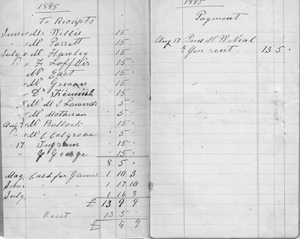
| 1895 / To Receipts | ||||
| June | Mr Willis | 15 |
||
| Mr Parrett | 15 |
|||
| July | Mr Hawley | 15 |
||
| F Loffler | 15 |
|||
| Mr East | 15 |
|||
| Mr Greaves | 15 |
|||
| Dr Kennish | 15 |
|||
| Mr M S Lowndes | 5 |
|||
| Mr Mathison | 5 |
|||
| Aug 7 | Mr Bullock | 15 |
||
| Mr C Colgrove | 5 |
|||
| " 17 | Ingram | 15 |
||
| G George | 15 |
|||
------------- |
||||
8 |
5 |
|||
| May | Cash for Games | 1 |
10 |
3 |
| June | " " | 1 |
17 |
10 |
| July | " " | 1 |
16 |
8 |
------------- |
||||
| Payments | £ |
13 |
9 |
9 |
| Aug 17 | Paid Mr W Neal ½ Year rent | 13 |
5 |
- |
------------- |
||||
£ |
4 |
9 |
||
1903: Buckingham Express, 11 April
BOWLING GREEN CLUB.- The annual meeting of this club, which now numbers 60 members, was held at the Bell Hotel on Friday evening, Mr. C. J. [=J.C.] Hawley in the chair. The senior steward, Mr. E. A. Illing, presented the balance-sheet for the year 1902 which showed the club’s income to have been £37 14s. 9d., and that it had a balance in hand of £8 8s. 1d., the best result known within the memory of the members, and a very hearty vote of thanks was passed to Mr. Illing on account of it. Mr. Illing was strongly pressed to act as one of the stewards for 1903, but owing to pressure of business was forced to decline, and Messrs. W. R. Hathaway, Jno. Buckingham, and G. Pass were appointed. It was decided to try and arrange matches with Bedford, Dunstable, and Bicester Clubs, also Lord Jersey’s team. A handicap for a pair of bowls was also arranged, and it was decided that the opening meeting should be on Easter Monday afternoon when it was hoped a good number of members would turn up. The following new members were elected- Mr. C. Danning, Mr. W. Brown, and the Rev. D. B. Montefiore (Mursley Hall).1911: Buckingham Advertiser, 8 April
We are glad also to note that the Bowling Green is still to be carried on. Some anxiety was felt [after the death of T.P. Willis] whether this venerable institution might not cease to exist, but fortunately the committee have been able to make very favourable terms for its continuance.
1914: Assessment for Bowling Green (TNA, IR 58/2348 no.225)
Situation Nr Church Yard
Description Bowling Green & Buildings
Gross Value: Land £21 Rateable Value: Land £16 - 15
Occupier Wm Sml Neal
Owner W.G.W. Willis, exor T.P. Willis decd, High St, Winslow
Interest of Owner Freehold
Occupier’s tenancy, Term Yearly
Actual Rent £21
Outgoings – Land Tax, £ 13/1 (with other heredits)
Who pays (a) Rates and Taxes (b) Insurance (a) T (b) L.
Who is liable for repairs L
Site value deductions claimed Yes
[stamp] 31 JUL 1912
Particulars, description and note made on inspection /6/12
The Bowling Green Enclosed and prettily surrounded with shrubs &c giving it additional value
Let to Club
Lot 15 Messrs Wigleys pars 2 r : 14 p
Valuation – Market Value of Fee Simple in possession of whole property in its present condition
let at 4% on cost £15 x 55
In accordance with agreement with Lessees £300 – 0 - 0
Deduct Market Value of Site under similar circumstances, but if divested of structures, timber, fruit trees, and other things growing on the land
120’ x £2 say (see over) £250
Difference Balance, being portion of market value attributable to structures, timber &c. £50
Divided as follows:-
Buildings and structures £ 15
Fruit Trees £ 35
Market Value of Fee Simple of Whole in in its present condition (as before) £300
GROSS VALUE £300
2844 yds @ 1/9 say £250
David Thomas Willis had two daughters. In 1859, the elder daughter, Maria Louisa Willis, married Thomas Newham, a surgeon, who lived at Western Lodge, Horn Street. They had a daughter, Ellen Mary, who in 1883 married George Richard Greaves of Western House, a mansion house which stood on the corner of Horn Street and Burleys Road. Greaves was an important figure in the Whaddon Chase Hunt and although his house has been demolished, part of his extensive stables on Horn Street have been converted into several dwellings. George Richard Greaves died in 1899, but his wife Ellen Mary lived on at Western House until her death in 1937. At the auction of Western House, 18 June 1937, Lot 6 was an enclosed kitchen garden adjoining the new churchyard. It was bought by Kenneth Joseph Robson of Western Lodge, Horn Street, for £110. He sold the garden to Charles Edwin Beane, a confectioner, of 14 Market Square Winslow. He in turn sold it, 19 March 1955, to Leslie Harcourt Melville, an estate agent, of The Corner, Hoggeston, for £200. It was described as "All that piece of garden ground containing 25 p[erches] or thereabouts walled around by brick walls and situate near the churchyard and the bowling green ... formerly part of All that enclosed close of pasture ground situate lying and being in Winslow aforesaid containing by estimation 1 acre more or less part of which close of pasture ground was long since converted into a bowling green and the residue thereof into gardens".
In 1868, David Thomas Willis’s younger daughter, Sarah Cowley Willis, married her cousin Thomas Price Willis, another solicitor, who lived at the large white house called The Elms, on the corner of High Street and Greyhound Lane. He died in 1909, but his property was marked on the Valuation Map of 1910. It included the Bowling Green, tenanted by W.S. Neal of the Bell Inn. At the auction of Thomas Price Willis’s property, 29 March 1911, the Bowling Green was described as "A highly attractive freehold enclosure comprising nearly ¾ acre known as the Bowling Green". It was later bought by Norman McCorquodale, of Winslow Hall. He gave the Bowling Green to the Church in 1926 as an extension to the burial ground.
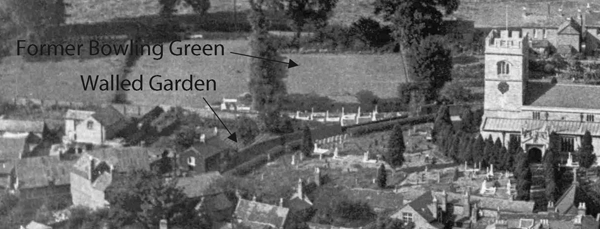
This aerial view shows the Bowling Green in the 1930s after it had gone out of use but before there were any graves on it
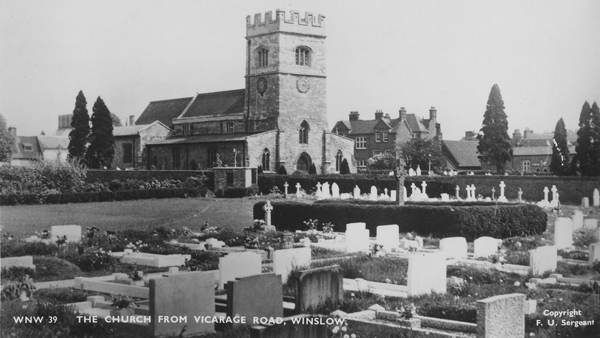
By the 1950s the hedge had been removed and the Bowling Green was absorbed into the churchyard. The small hedge in the centre of the photo surrounded the McCorquodale family monument. The building visible on the right of the Church is the Bank.
See also:
